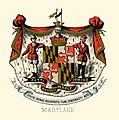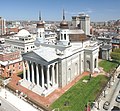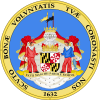Portal:Maryland
|
Maryland Portal
|
Baltimore Task Force
|
Frederick Task Force
|
Montgomery Task Force
|
WikiProject Maryland
|
|
Main page
|
Discussion
|
Introduction Maryland (US: /ˈmɛrɪlənd/ ⓘ MERR-il-ənd) is a state in the Mid-Atlantic region of the United States. The state borders Virginia to its south, West Virginia to its west, Pennsylvania to its north, Delaware to its east, the Atlantic Ocean, and the national capital of Washington, D.C. With a total area of 12,407 square miles (32,130 km2), Maryland is the ninth-smallest state by land area, and its population of 6,177,224 ranks it the 18th-most populous state and the fifth-most densely populated. Maryland's capital is Annapolis, and the most populous city is Baltimore. Occasional nicknames include Old Line State, the Free State, and the Chesapeake Bay State. It is named after Henrietta Maria, the French-born queen of England, Scotland, and Ireland during the 17th century. The western portion of the state contains numerous stretches of the Appalachian Mountains, the central portion is primarily composed of the Piedmont, and the eastern side of the state makes up a significant portion of Chesapeake Bay. Maryland's coastline was first explored by Europeans in the 16th century. Prior to that, it was inhabited by several Native American tribes, mostly the Algonquian peoples and, to a lesser degree, Iroquoians and Siouans. As one of the original Thirteen Colonies of England, Maryland was founded by George Calvert, 1st Baron Baltimore, a Catholic convert who sought to provide a religious haven for Catholics persecuted in England. In 1632, Charles I of England granted Lord Baltimore a colonial charter, naming the colony after his wife, Henrietta Maria. Unlike the Pilgrims and Puritans, who rejected Catholicism in their settlements, Lord Baltimore envisioned a colony where people of different religious sects would coexist under the principle of toleration. (Full article...) This is a Featured article, which represents some of the best content on English Wikipedia..
 Thomas F. Mulledy SJ (/mʌˈleɪdi/ muh-LAY-dee; August 12, 1794 – July 20, 1860) was an American Catholic priest and Jesuit who became the president of Georgetown College, a founder of the College of the Holy Cross, and a Jesuit provincial superior. His brother, Samuel Mulledy, also became a Jesuit and president of Georgetown. Mulledy entered the Society of Jesus and was educated for the priesthood in Rome, before completing his education in the United States. He twice served as president of Georgetown College in Washington, D.C. At Georgetown, Mulledy undertook a significant building campaign, which resulted in Gervase Hall and Mulledy Hall (later renamed Isaac Hawkins Hall). He became the second provincial superior of the Maryland Province of the Jesuit order, and orchestrated the sale of the province's slaves in 1838 to settle its debts. This resulted in outcry from his fellow Jesuits and censure by the church authorities in Rome, who exiled him to Nice in the Kingdom of Piedmont-Sardinia for several years. While provincial superior, Mulledy was also the vicar general for the Diocese of Boston. (Full article...)General imagesIn the news
On this day...The Maryland portal currently doesn't have any anniversaries listed for April 27. You can help by viewing the page source of an existing entry at /On this day to see how the entries should be formatted, then adding the missing entry. This is a Good article, an article that meets a core set of high editorial standards.
The Johns Hopkins–Maryland lacrosse rivalry is an intercollegiate rivalry between the Johns Hopkins Blue Jays, which represent Johns Hopkins University, and the Maryland Terrapins, which represent the University of Maryland. The most prominent event has been the men's lacrosse series, which is widely regarded as one of the greatest rivalries in the sport. More than 115 contests in the series have been played since the schools first met in 1895. The competition is intensified by each program's status as a traditional lacrosse powerhouse. As such, the game has often held national championship implications, and twice the teams played to represent the United States in the Olympics. The schools currently meet only in lacrosse, as all other Johns Hopkins athletics fall under NCAA Division III and all Maryland athletics are Division I. From the late 19th into the 20th century, however, their football teams also competed regularly. More recently, the schools have played in women's lacrosse. (Full article...)Selected article -Germantown is an urbanized census-designated place in Montgomery County, Maryland. With a population of 91,249 as of the 2020 census, it is the third most populous place in Maryland, after Baltimore and Columbia. Germantown is located approximately 28 miles (45 km) outside the U.S. capital of Washington, D.C., and is an important part of the Washington metropolitan area. Germantown was founded in the early 19th century by European immigrants, though much of the area's development did not take place until the mid-20th century. The original plan for Germantown divided the area into a downtown and six town villages: Gunners Lake Village, Kingsview Village, Churchill Village, Middlebrook Village, Clopper's Mill Village, and Neelsville Village. The Churchill Town Sector at the corner of Maryland Route 118 and Middlebrook Road most closely resembles the center of Germantown because of the location of the Upcounty Regional Services Center, the Germantown Public Library, the Black Rock Arts Center, and pedestrian shopping that features an array of restaurants. Three exits to Interstate 270 [I-270] are less than one mile away, the Maryland Area Regional Commuter train is within walking distance, and the Germantown Transit Center that provides Ride On shuttle service to the Shady Grove station of the Washington Metro's Red Line. (Full article...)Did you know?

SubcategoriesSelect [+] to view subcategories
TopicsRelated portalsAssociated WikimediaThe following Wikimedia Foundation sister projects provide more on this subject:
Discover Wikipedia using portals |























































